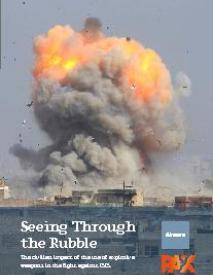Seeing Through the Rubble : The civilian impact of the use of explosive weapons in the fight against ISIS.
This report demonstrates the dire and long lasting impact on civilians of the recent international coalition’s campaign in Mosul, Raqqa and Hawijah and calls for stronger international commitment against the use of explosive weapons in populated areas.
The past decade has seen a significant and disturbing shift towards large-scale urban combat across multiple conflicts where heavy use of explosive weapons such as aircraft bombs, missiles and artillery shells has been a central feature—leading in turn to very significant civilian casualties and to major destruction of critical infrastructure.
Cities including Aleppo, Raqqa, Mosul, Hawijah, Sirte, Tripoli and Marawi have become synonymous in recent years with wide-scale destruction and extensive civilian harm. In 2019, of the 19,401 civilian deaths and injuries from the use of explosive weapons in populated areas that were tracked globally by Action on Armed Violence, some 92 per cent reportedly occurred in urban areas.1
As the International Committee of the Red Cross (ICRC) has noted, “Modern armed conflicts are increasingly fought in urban environments, with millions of people bearing the brunt of their tragic consequences. This trend has a catastrophic impact on the civilian population and poses serious legal and operational challenges that need to be addressed to ensure that people living in such environments are protected and their needs cared for.”2
The civilian harm caused by explosive weapons use in towns and cities extends well beyond the time and place of the attack. Explosive weapons are a main driver of forced displacement and have a profound impact upon critical infrastructure services such as health care, education and water and sanitation services. This pattern of harm has spurred international discussions on how to prevent this harm and has led to the start of international negotiations on a political declaration to strengthen the protection of civilians from harm arising from the use of explosive weapons in populated areas.
Most Western militaries claim that their operations have been conducted in compliance with International Humanitarian Law (IHL), and that they are already well-equipped to limit civilian harm from explosive weapons during operations fought in towns, cities and other populated areas. Rebuffing reports in 2017 of severe civilian harm during the war against the so-called Islamic State of Iraq and Syria (ISIS), then-commander Lieutenant General Stephen Townsend asserted for example:
“In accordance with the law of armed conflict, the Coalition strikes only valid military targets after considering the principles of military necessity, humanity, proportionality, and distinction. I challenge anyone to find a more precise air campaign in the history of warfare. The Coalition’s goal is always for zero human casualties. We apply rigorous standards to our targeting process and take extraordinary efforts to protect non-combatants.”3
However, precision has proven not to be a key determinant of civilian harm during urban combat. Even relatively precise explosive weapons have caused extensive harm, creating effects that extend beyond the target zone in populated areas. Furthermore, civilian casualties are not the only measure of civilian harm. Instead, states should look at the full range of impacts. The long-lasting and devastating impact of International Coalition airstrikes on Mosul, Raqqa and Hawijah, in combination with other explosive weapons such as artillery, show us how high the stakes are for the people who were freed from ISIS at such great cost and now have to deal with the impact that their liberation has had on their towns and cities.
This report sheds light on why there is a need to better address the impact from explosive weapons and to protect civilians through improved military operational standards. In presenting this report, we call upon all states to offer civilians better protection against the use of explosive weapons, to negotiate a strong international political declaration to this end and to commit to avoiding the use of explosive weapons with wide area effects in populated areas.
Geachte bezoeker,
De informatie die u nu opvraagt, kan door psychotraumanet niet aan u worden getoond. Dit kan verschillende redenen hebben,
waarvan (bescherming van het) auteursrecht de meeste voorkomende is. Wanneer het mogelijk is om u door te verwijzen naar de bron
van deze informatie, dan ziet u hier onder een link naar die plek.
Als er geen link staat, kunt u contact opnemen met de bibliotheek,
die u verder op weg kan helpen.
Met vriendelijke groet,
Het psychotraumanet-team.
46 pagina's | Utrecht en Londen : PAX en Airwars
https://www.paxforpeace.nl/publications/all-publications/seeing-through-the-rubble


